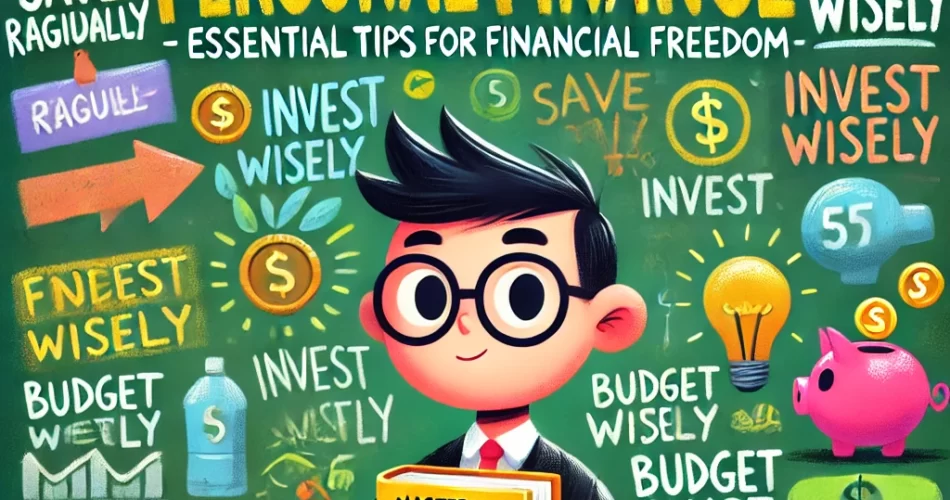Introduction: How to Take Control of Your Personal Finance

In today’s fast-paced world, mastering personal finance is more crucial than ever. With the rising cost of living, unpredictable economic changes, and increasing debt, it’s easy to feel overwhelmed. However, by following a few essential financial management tips, you can take control of your money and build a stable future. Whether you're struggling to save, invest, or plan for retirement, these strategies will guide you toward achieving financial freedom.
In this guide, we’ll explore the key areas of personal finance management, including budgeting, saving, debt repayment, and investing. With these practical tips, you'll feel more confident about your financial future.

1. Understanding Personal Finance: The Basics
To master your personal finance, it’s essential to understand the basics. Personal finance management refers to all the decisions and activities you engage in to manage your money effectively. This includes:
- Budgeting: Allocating your income to cover expenses while ensuring savings and investments.
- Saving: Setting aside money for future expenses, emergencies, and long-term goals.
- Investing: Growing your wealth through investments such as stocks, bonds, or real estate.
- Debt Management: Paying off debt to improve your financial situation.
These core areas are the foundation of financial success. By focusing on each, you’ll ensure a balanced approach to managing your money.

2. Creating a Budget that Works
One of the most critical aspects of personal finance management is budgeting. Without a clear budget, it’s easy to lose track of spending, leading to debt and financial stress.
Here’s how to create a budget that works:
Step 1: Calculate Your Monthly Income
Start by determining your total monthly income. This includes your salary, freelance income, side hustles, and any other sources of earnings. Knowing your exact income will help you allocate funds more effectively.
Step 2: Track Your Expenses
For a successful budget, track your spending for at least a month. Group expenses into categories like housing, food, transportation, entertainment, and savings. Tools like Mint or YNAB (You Need A Budget) can help automate this process.
Step 3: Set Realistic Financial Goals
Your budget should reflect your financial goals. Whether it’s paying off debt, saving for a vacation, or building an emergency fund, set clear objectives. A great rule of thumb is the 50/30/20 rule:
- 50% for essential needs (rent, groceries, utilities)
- 30% for discretionary spending (dining out, entertainment)
- 20% for savings and debt repayment
By following these budgeting tips, you’ll be able to allocate your income toward things that matter most, ensuring financial stability and peace of mind.

3. Smart Saving Techniques
Saving money is an essential part of any financial plan, but it’s often easier said than done. Whether you're saving for an emergency fund, a down payment on a home, or retirement, the key is to develop smart saving habits.
Automate Your Savings
Set up an automatic transfer from your checking account to your savings account each month. By automating your savings, you remove the temptation to spend the money and ensure consistent contributions toward your financial goals.
Cut Unnecessary Expenses
Review your spending habits regularly. You might find small but recurring expenses—like coffee shop visits or subscription services—that can be reduced or eliminated. By cutting out these unnecessary costs, you’ll free up more money to put into savings.
Utilize High-Yield Savings Accounts
To maximize your savings, consider a high-yield savings account. These accounts typically offer better interest rates than traditional savings accounts, allowing your money to grow faster.

4. Paying Off Debt Strategically
Debt can feel like a heavy burden, but with a solid repayment strategy, it’s possible to pay off your debt faster and save on interest. Here are two popular debt repayment strategies:
The Debt Snowball Method
With the debt snowball method, you pay off your smallest debt first while making minimum payments on the rest. Once the smallest debt is paid, you move to the next smallest. This method provides psychological victories as you see debts disappear, motivating you to continue.
The Debt Avalanche Method
The debt avalanche focuses on paying off the debt with the highest interest rate first, saving you more money in the long run. This approach is often considered more cost-effective, though it can take longer to see significant progress.
No matter which method you choose, the key is consistency and discipline in making extra payments whenever possible.

5. Investing for the Future
Investing is one of the most powerful ways to build long-term wealth. While it might seem intimidating, anyone can start investing with the right knowledge and strategy.
Start Small
If you’re new to investing, start small by putting a portion of your income into investment accounts like a 401(k) or an IRA. These tax-advantaged accounts are great for retirement savings and typically offer employer matching, maximizing your contributions.
Diversify Your Investments
A well-diversified portfolio reduces risk. Instead of putting all your money into one type of investment, spread it across different assets like stocks, bonds, and real estate. This strategy ensures that even if one investment underperforms, others can help mitigate your losses.
Consider Index Funds
For beginners, index funds are an excellent option. These funds track market indexes, providing broad exposure to various stocks without the need to pick individual companies. They also come with lower fees, making them a cost-effective way to invest.

6. Building an Emergency Fund
An emergency fund is a crucial component of a sound financial plan. It serves as a safety net, protecting you from unexpected expenses such as medical bills, car repairs, or job loss.
How Much Should You Save?
A good rule of thumb is to have 3-6 months' worth of living expenses in your emergency fund. This amount will give you peace of mind and allow you to handle unexpected financial challenges without going into debt.
Where to Keep Your Emergency Fund
Since emergencies can arise at any time, it’s essential to keep your emergency fund in an accessible place like a high-yield savings account or money market account. Avoid putting it into stocks or other volatile investments, as you may need to access it quickly without losing money.

7. Planning for Retirement
It’s never too early—or too late—to start planning for retirement. With longer lifespans and rising healthcare costs, having a solid retirement plan is crucial to ensure financial security in your later years.
Maximize Retirement Accounts
Take advantage of employer-sponsored retirement accounts like a 401(k), especially if your employer offers matching contributions. If you’re self-employed, consider opening a Roth IRA or SEP IRA to benefit from tax-advantaged growth.
Estimate Future Expenses
When planning for retirement, estimate your future living expenses. Factor in housing, healthcare, and potential leisure activities. Knowing your target retirement savings will help you stay on track.
Conclusion: Take Charge of Your Financial Future
Mastering personal finance doesn’t happen overnight, but with the right approach, you can take control of your financial future. Start by creating a realistic budget, saving consistently, paying off debt, and investing for long-term growth. By implementing these personal finance tips, you’ll be well on your way to achieving financial freedom and living the life you want.

